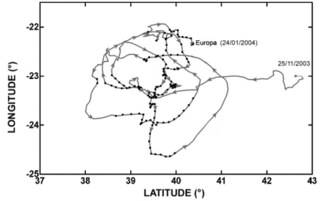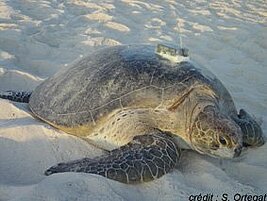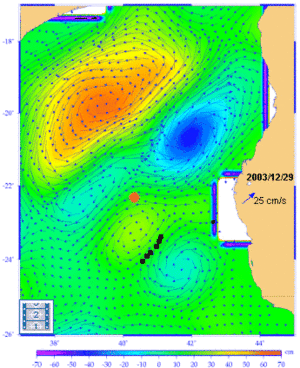Most sea turtles are known for their attachment to coastal feeding grounds and reproduction sites as well as for their surprising orientation capability which enables them to periodically migrate between these sites. Their performances are even more astounding in that the beaches on which the females come to lay their eggs are sometimes located on small isolated islands in the middle of the ocean, several hundreds or even thousands of kilometres from their feeding sites. The mechanisms and information used by turtles to find their way over great distances in the open ocean are still little known, but several hypotheses have been put forward: some researchers have suggested that the turtles use olfactory information (under water and/or in air) while others believe that they use information provided by the geomagnetic field. In order to observe and try to understand the navigating behaviour of sea turtles, scientists fit them with Argos transmitters and track their movements.
However, in former studies, the mechanical effect of currents on the movement of turtles was never quantified. New developments in space oceanography have now made it possible to estimate fairly accurately the currents encountered by turtles during their oceanic migrations. Biologists (from the University of Pisa, CNRS, IRD and Ifremer) and oceanographic physicists (from Legos/CTOH) have thus worked together to try and understand the impact of currents on turtle movements.
Left : Homing journey of a turtle (tracked by Argos) which had been moved and released 245 km to the South-East of Europa Island. After 59 days, during which it travelled 3,515 km, it finally returned to its laying site. The tracks which were analysed independently of ocean currents, suggests that this particular turtle was not very efficient in orienting itself towards its laying site but that it nevertheless vaguely estimated the direction of Europa. (Credits Pisa University/CNRS/IRD)
Right : A green turtle (Chelonia mydas) with an Argos transmitter (Credits S. Ortegat).
In November 2003, a so-called homing experiment was undertaken from Europa, which is a small isolated island located in the southern part of the Mozambique Channel. It consisted in taking three female green turtles (Chelonia mydas) off their laying beach just before they returned to the sea, fitting them with Argos transmitters and releasing them at either 112 or 245 km to the South-East of the island. During their reproduction season, the green turtles lay eggs several times on the same beach; when moved from this site at the beginning of the reproduction season, they are strongly motivated to return to it. This type of experiment is thus designed to study their ability to find their way, to test different orientation hypotheses and to study the mechanical impact of currents on their movements.
Homing journey for the same turtle (black dots) towards the island of Europa (red dot) showing sea surface height anomalies and total current velocities (absolute geostrophic current + wind component). The animation shows that after first moving towards the West, where the turtle ran into opposing or cross-cutting currents, the four loops it travelled correspond to cyclonic and anticyclonic eddies. This observation suggests that the ocean currents in the area had a strong impact on the turtle's homing journey. Hence it appears that, not considering the mechanical impact of currents on sea turtle tracks can lead to misleading conclusions. This example shows the usefulness and indeed the necessity of extracting the current component from turtle tracks in order to determine their own water-related movements (i.e. their swimming movements) and study their spatial behaviour, in particular their orientation abilities.
View the animation (3 MB)
(Credits Pisa University/CNRS/IRD (tracking), Aviso (anomalies), Legos/CTOH (currents))
See also:
- Image of the Month, July 2004 : Leartherback turtles round eddies.
Websites on this subject:
- SeaTurtle.org
- Center of Studies and Cares for Sea Turtles (Aquarium La Rochelle)
References:
- Girard C., Sudre J., Benhamou S., Roos D. & Luschi P. Homing in green turtles (Chelonia mydas): do oceanic currents act as a constraint or as an information source?, Marine Ecology Progress Series (in press)
- Girard C. 2005. Etude du comportement d'orientation d'espèces pélagiques tropicales vis-à-vis d'attracteurs. University of La Réunion Ph.D. thesis, 250 p.





















